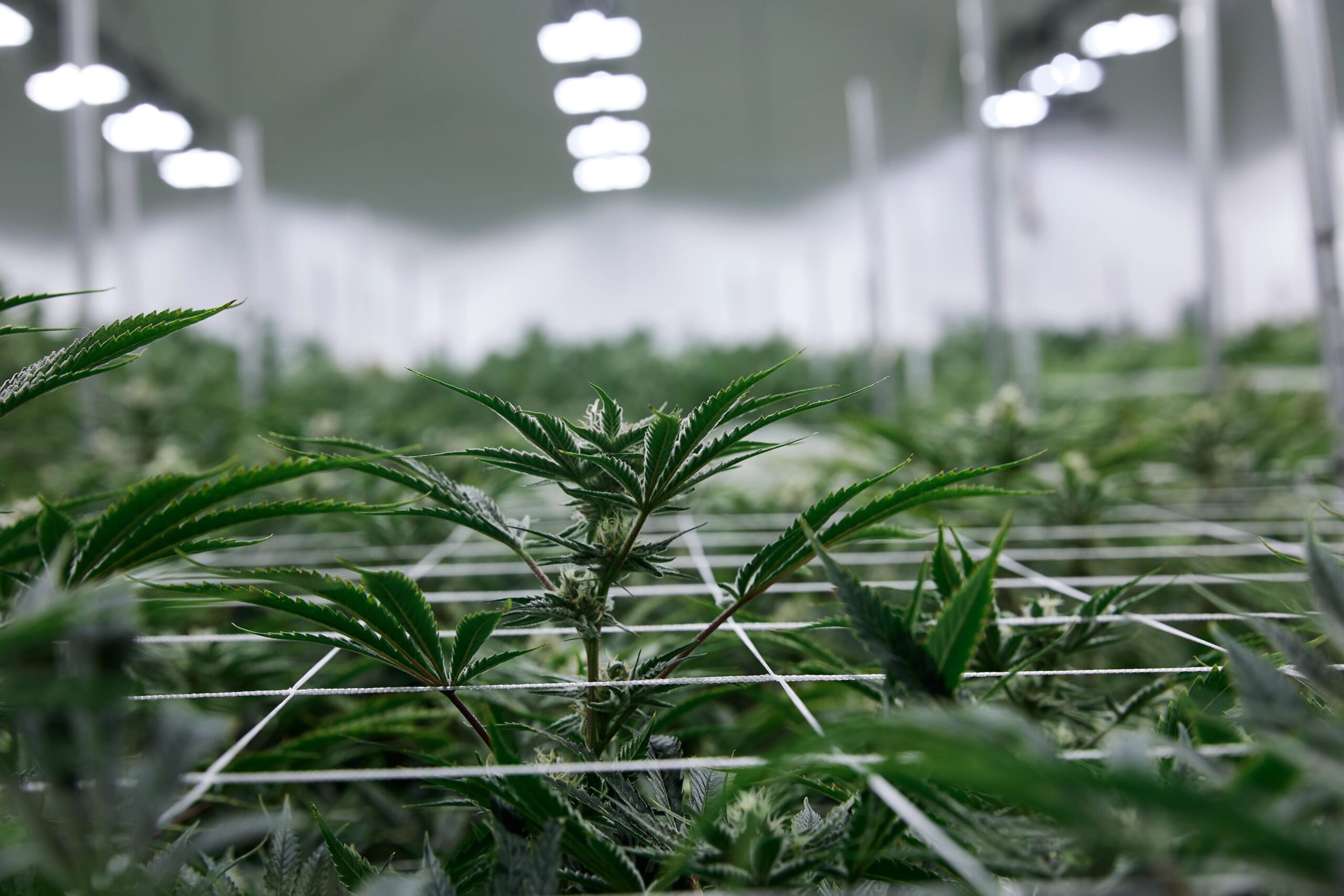Achieving a bountiful harvest of high-quality cannabis relies heavily on maintaining healthy plants. Even the most experienced of cultivators will inevitably be faced with plant health issues of one kind or another. If you're new to home-growing cannabis, learn the basics of the process and see what you can do to produce a flourishing crop.
Plant stress: Indoor vs outdoor-grown cannabis
Whether you're working with an indoor or outdoor grow, plants don't like surprises. A nice, normal day with appropriate amounts of light, food, and water suits it perfectly. But when life happens, plants experience stress. Plant stress is a state in which your plant is growing in less-than-ideal conditions.
Stress events cause changes in the plant's internal chemistry that can result in delayed growth, decreased yields, damage, or death if the stress exceeds the plant's limits. Plant stress can be induced by adverse physical conditions or harmful biological agents, and understanding the many potential stresses that can affect cannabis is the first step in ensuring its health.
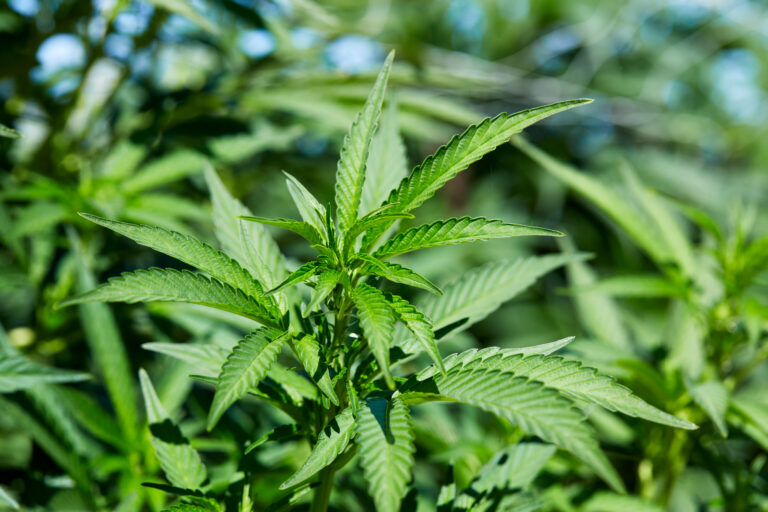 Photo by: Gina Coleman/Weedmaps
Photo by: Gina Coleman/WeedmapsImage lightbox

Certain forms of stress are easier to manage than others, depending on whether the plant is grown indoors or outdoors. Outdoor plants are extremely susceptible to physical damage that can result from fierce winds. This factor can be easily mitigated indoors by precisely controlling the speed and direction of air movement using wall-mounted fans and a proper heating, ventilation, and air conditioning (HVAC) system.
Managing your crop's health is a complex balancing act that requires you to spend time with your plants and be willing to learn. Pay close attention and attempt to control as many factors as possible to prevent your grow from being afflicted by one or more forms of plant stress.
The most common forms of plant stress:
- Water stress: This can occur when the plant either receives excessive or not enough water and can cause the stomata, the key reactants in photosynthesis, to close and cease to transpire.
- Nutrient stress: Excessive, insufficient, or imbalanced nutrients can make the plant more susceptible to disease. Insufficient nutrients can substantially slow a plant's growth and ultimately reduce the overall yield. Being able to diagnose nutrient deficiencies visibly is a clear sign that the problem is already advanced.
- pH stress: Growing media and water pH are critical factors in a plant's ability to absorb the available nutrients. A pH that is too high or too low will prevent the roots from effectively taking up the proper balance of nutrients and can lead to nutrient lockout or the inability to use certain nutrients. pH stress can affect plants indoors or outdoors regardless of environmental conditions.
- Age stress: As plants age, their nutrient needs change. Their overall vigor will diminish, and their tissues will become hard and woody. This particularly applies to mother plants that have been kept in a vegetative state for extended periods.
- Irregular light cycles: Plant exposure to irregular photoperiods can cause a hormone imbalance that can confuse your plant and force it to flower prematurely or revert to the vegetative stage during the flowering cycle. This can be a large problem for outdoor growers as the light from a full moon can trick some cultivars into diverting their energy toward vegetative growth during the flowering stage.
- Plant damage: Physical damage to the plant (e.g., over-pruning, the wind breaking a branch, etc.) can redirect valuable resources to repair the wound, thereby reducing the nutrients needed to continue vegetative growth or extend flower production.
- Environmental extremes: Very high or low temperatures and humidity or fluctuations in temperature and humidity can severely affect essential cellular processes within the plant and lead to numerous plant health issues. If stressed enough, unpollinated female plants can produce viable seeds in a last-ditch effort for survival, reducing overall flower yields.
- Insects and disease stress: Considered to be a form of biotic stress, insects and internal disease can cause damage, compromising the plant's immune system and leading to decreased yields or death. Some insects feed on the leaves of the plant, extracting the plant's leaf cells and ultimately reducing the plant's ability to retain water and transpire through its leaves. While these insects may not immediately kill your plant, they will reduce the overall yield. If left untreated, they will take over the plant and render it useless.
How to properly water cannabis plants
Fresh plant matter consists of about 80% – 95% water, so it shouldn't be surprising that water quality and the amount of water you give your plants are vital to the health of your crop.
Plants mainly use water in four ways:
- To stand upright and pump up like a balloon—this is referred to as turgor pressure. Water enters through the roots via osmosis, travels up the plant through the plant's vascular tissues, and exits through the stomata on the underside of the leaves. When the plant does not have adequate access to water, this process slows, turgor pressure drops, and the plant wilts.
- Transpiration is the process of water evaporating from the underside of the plant's leaves, helping to keep the plant cool. Transpiration is akin to human sweating: Just as humans sweat more on a hot day, the rate of transpiration for plants increases on a hot day, which in turn increases the amount of water the plant needs.
- Water acts as a transportation medium for the plant. It brings nutrients up from the roots in the xylem and transports sugars and metabolites up or down the phloem. The xylem and phloem can be thought of as the major highways of the plant's structure.
- Plants take the hydrogen atom from a water (H2O) molecule and use it to build sugars, which they then use as energy.
Water quality
Not all water is delivered equally, and the quality of the water you use in your garden plays a big role in growing a healthy crop. Cultivators should take the time to determine the source of their water and its contents to see whether it needs to be treated prior to use. Water can contain contaminants that affect the health of your plants and ultimately reduce their overall yield.
Most common contaminants found in water:
- Heavy metals: arsenic, cadmium, lead, mercury
- Minerals: calcium, magnesium, nitrates, sulfates
- Microbiological: E. coli, salmonella, aspergillus
- Total dissolved solids (TDS)
- Carbonates
- Nitrates
- Sulfates
- Chlorine and chloramines
- Pesticides
The levels or presence of contaminants in your water can vary depending on your location and the source of your water (e.g., well, municipal water, springs, etc.). Some contaminants can be fatal to plants, while others affect the nutritional profile and can lead to deficiencies. Water quality reports can be obtained from your service provider and generally report the amount of chemical contaminants in parts per million (PPM) and heavy sediment in total dissolved solids (TDS).
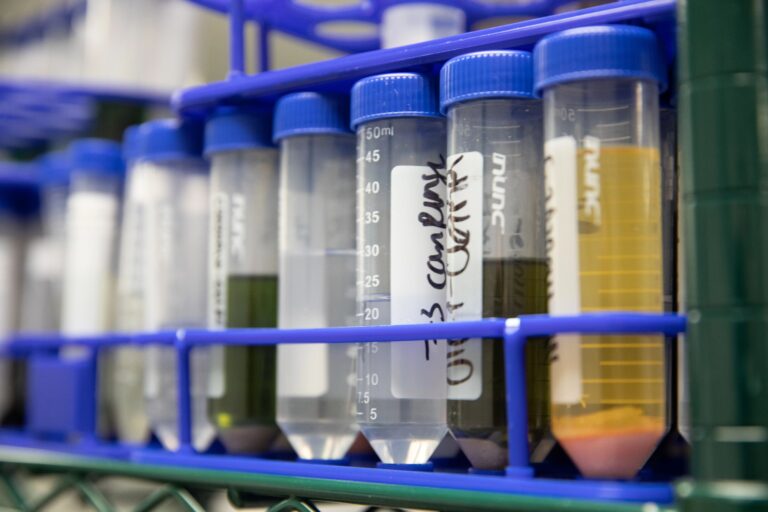 Photo by: Gina Coleman/Weedmaps
Photo by: Gina Coleman/WeedmapsImage lightbox

Hard water contains high levels of calcium and magnesium in a form that your plants cannot readily use. This prevents healthy growth and absorption of some nutrients. Calcium and magnesium make up the majority of the PPM count in most water.
Municipal water regularly contains chloramine or chlorine for disinfection. Both can harm plants and kill beneficial bacteria. Chloramine is more commonly used today in municipal water systems than chlorine. Chlorine can be removed by aerating water in a container for 24 hours with an air pump. Chloramine is more difficult to remove with aeration and must be removed through filtration.
To ensure that crops receive the perfect water chemistry each time they are watered and fed, most cultivators choose to filter their starting water in order to maintain the same starting point throughout the season. As a general rule, if your water contains more than 50 PPM, it will need to be filtered. The type of filtration unit you should use depends on how much water you need daily and the quality of your starting water.
Most common types of water filtration systems:
- Reverse osmosis (RO) filters are capable of removing 95% or more of contaminants, resulting in water free of contaminants. They produce wastewater as a byproduct and their filtration membranes can be sensitive. As a result, pre-filters like the ones described below are placed before RO filters to increase their efficiency and longevity.
- Carbon or sediment filters are used to dechlorinate, or remove chlorine and chloramine from, water and remove larger solids such as sediment and dirt. They have a fast flow rate and do not produce wastewater. These filters do not lower the PPM count of your water but rather the amount of TDS.
- Water softeners can also be used for hard water and are commonly placed before an RO filter. They function by exchanging calcium and magnesium for sodium chloride, which can then easily be removed with an RO filter.
Water temperature
Once the water is free of contaminants it is important to check its temperature and make sure it has a substantial amount of oxygen. Dissolved oxygen (DO) is the term used to reference the quantity of oxygen that is dissolved in your water. DO promotes vigorous root growth, enhances nutrient uptake, and helps to prevent the growth of bacteria forms that can only survive in a non-oxygen-rich environment. The colder the water, the more DO your water can hold.
Ideally, you want the temperature of your water to be 72°F (22°C), which will hold approximately 5 - 8% DO. Air pumps and air stones are frequently used to pump oxygen into reservoirs to increase the DO content, but these systems are not very efficient. A recirculating pump to break the surface tension of the water in your reservoir or a vortex-style reservoir is a much more efficient option for adding DO. You cannot over-oxygenate your water because it dissipates rather quickly; the more oxygen, the better.
Irrigation and watering frequency
Some of the most common questions asked by new cultivators revolve around “How much water do I give my plants?” and “How often should I water my plants?” While there are no simple answers, there are some good guidelines and tips that can help you keep your plants properly hydrated. Watering your plants is a balancing act of not giving them too much or too little, and with some practice, it becomes routine.
Major factors that influence irrigation volume and frequency:
- Plant stage of growth: Plants tend to require more watering volume and frequency as they progress through the flowering cycle.
- Temperature and humidity: The hotter the temperature and the higher the humidity, the more frequently a plant will need to be watered.
- Type of medium: A medium's water-holding capacity is highly dependent on several factors, so it is best to familiarize yourself with one medium at a time. As a rule, the more porous the medium, the more frequently it will require water (e.g., coco coir will require more frequent waterings than a plant grown in soil).
The golden rule for watering plants is “transpiration before irrigation.” At night, the stomata on the underside of the leaves close, and transpiration ceases. Therefore, it is a bad idea to water your plants in the dark. In the morning, when your plants “wake up,” it takes an hour or so of sunlight for your plants to resume transpiring, and at this point, it is OK to start watering them. It is best to water your plants early in the day, if possible.
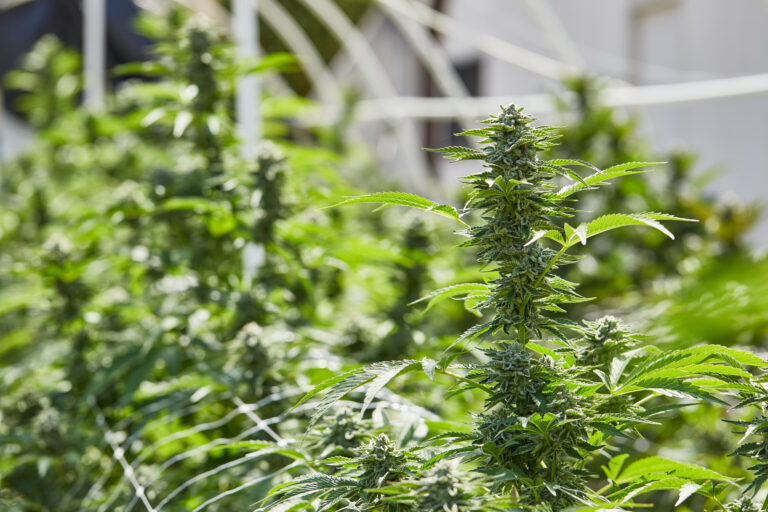 Photo by: Gina Coleman/Weedmaps
Photo by: Gina Coleman/WeedmapsImage lightbox

The biggest mistake new cultivators make is overwatering. Roots need plenty of oxygen to grow, and a constantly saturated medium essentially drowns the plant. Overwatered plants tend to droop, with leaves that are firm, dark green, and curl inwards. If your plants show these symptoms while the medium is still plenty wet, this is a clear sign that you are overwatering. The remedy is to reduce the frequency of your watering schedule.
Underwatered plants look weak and brittle and show signs of wilting. The leaves feel papery and thin, while the stems feel like they can be snapped easily. Typically, your medium will also feel very dry, and the container will be lighter in weight. In this situation, the remedy is to simply increase the volume or frequency of your irrigations.
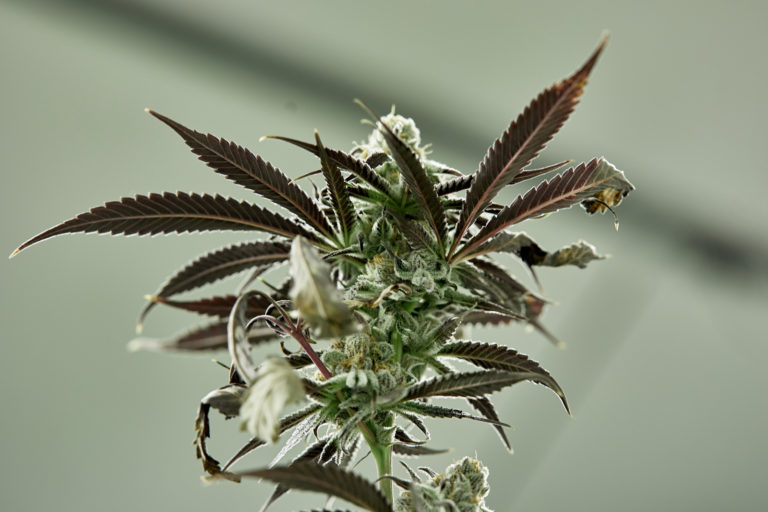 Photo by: Gina Coleman/Weedmaps
Photo by: Gina Coleman/WeedmapsImage lightbox

If a big plant is in a small container and constantly seems underwatered, then it's a sign that you need to transplant up to a larger container to give the roots more access to water.
Tips on watering your cannabis plants:
- Frequently pick up or lift your containers to get a feel for how much they weigh when fully saturated, again when some of the water has evaporated, and again when they are practically dry. This will help you determine when you need to water.
- Never let your medium completely dry out. This is particularly important during the flowering phase.
- If you are consistently adding nutrients to your water, you will need to check that 5-20% of the nutrient-rich water is drained through the plant. This is commonly called runoff. Without sufficient runoff, the nutrient salts will build up in your medium and become toxic to your plant.
- If you are not adding nutrients to your water, you want less runoff to make sure you are not flushing out nutrients your plant needs.
- For loose media like soil, the top inch, or 2.54 centimeters or so, should be dry before you water again. You can check this by touching the medium.
For more advanced cultivators, water content meters and sensors are helpful in determining the most efficient irrigation schedule. Digital sensors that log data are a great way to monitor exactly when your plants wake up and start feeding, when it's best to irrigate, and how long it takes for your medium to dry out.
Best nutrients for optimum cannabis plant health
While 92 natural mineral elements are identified, only 17 elements are considered essential for plant growth. These 17 elements are broken down into two categories: macronutrients and micronutrients. As the names imply, macronutrients are required in relatively higher amounts than micronutrients.
- Macronutrients (9): Hydrogen, carbon, oxygen, nitrogen, potassium, calcium, magnesium, phosphorus, and sulfur
- Micronutrients (8): Chlorine, iron, manganese, boron, zinc, copper, molybdenum, and nickel
Hydrogen, carbon, and oxygen make up about 96% of dry plant tissue—these are obtained as carbon dioxide in the air and water. All the other nutrients are obtained in mineral form. These are commonly sold as salt-based soluble powders or concentrated liquids. It is important that all of these essential nutrients are applied to your plants in the correct ratio for their stage of growth and are not given in excess amounts.
Liebig's Law of the Minimum regarding plant nutrition states that growth is not dictated by the total resources available but by the scarcest resource or limiting factor. This is essentially a scientific way of saying, “More is not always better.” Just like humans, a plant's diet must be properly balanced and not overloaded with toxic amounts of one nutrient or another.
Changing nutrients over time
As the plant progresses from the vegetative stage to the flowering phase, the nutrient requirements change. The amounts and ratios of the primary macronutrients nitrogen, phosphorus, and potassium (commonly referred to as N-P-K on soil and nutrient packaging) have the biggest influence on the growth of your plant. Cannabis uses a lot of nitrogen during the vegetative phase to grow lush green leaves packed with chlorophyll and relatively lower amounts of phosphorus and potassium.
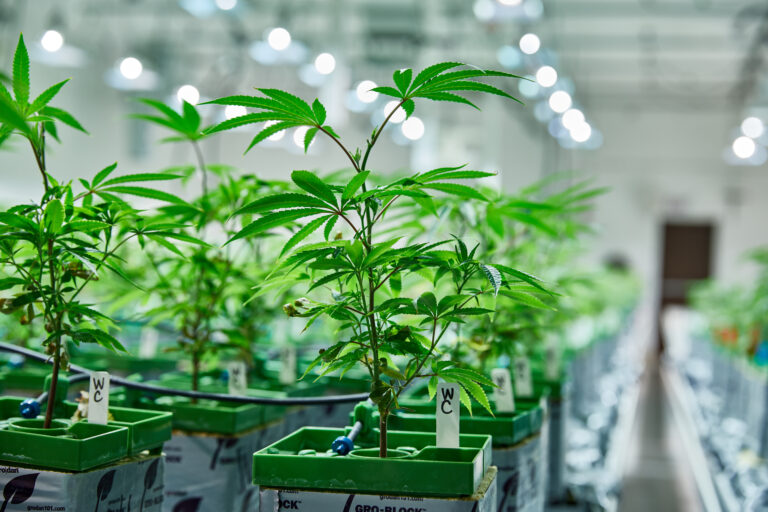 Photo by: Gina Coleman/Weedmaps
Photo by: Gina Coleman/WeedmapsImage lightbox

Flowering nutrients contain much lower levels of nitrogen and higher levels of phosphorus and potassium. Phosphorus is primarily responsible for root and flower production, whereas potassium improves the overall functions of the plant and aids in getting water into and out of cells. It is important to pay attention to this when switching plants from the vegetative stage to the flowering phase, and this is also why different nutrient formulations are sold for either vegetative growth or flowering growth.
Diagnosing nutrient deficiencies
Plant nutrients enter through the roots as ions, which are atoms or molecules with a net electric charge due to the loss or gain of one or more electrons. These varying positive and negative charges create a giant electrical battle that is constantly being fought within the root zone and in your plant. In short, these ionic charges and other factors influence the mobility of each nutrient once inside the plant.
- Mobile Nutrients: Nitrogen, phosphorus, potassium, magnesium, chlorine, nickel, and molybdenum
- Immobile Nutrients: Calcium, sulfur, boron, copper, iron, manganese, and zinc
When there is a short supply of mobile nutrients, the plant directs them to areas of new growth, so signs of deficiency show up in older parts of the plant. If there is a lack of immobile nutrients, deficiency symptoms tend to show up in these newer areas. For example, nitrogen is relatively mobile throughout the plant, whereas calcium is notoriously immobile. So nitrogen deficiencies tend to show up in older, lower leaves, while calcium deficiencies tend to show up in new growth areas towards the top of the plant or growth tips.
This concept of nutrient mobility is the basis for visually diagnosing deficiencies, which is a tool commonly referred to as the dichotomous keys. Although helpful, a visual diagnosis of nutrient deficiencies can sometimes be unreliable due to numerous factors that influence nutrient mobility. Professional cultivators analyze sample plant tissues at their local lab to precisely diagnose nutrient imbalances within their plants.
Importance of pH levels
If you suspect your plant may have a nutrient deficiency issue, it is important to check your pH first, as most nutrient problems typically stem from an improper pH level. The pH of a solution tells you the concentration of hydrogen ions (H+) and is a measure of how acidic or alkaline the solution is. It ranges from 1 to 14, with 1 being very acidic, 7 being neutral, and 14 being highly alkaline or basic.
pH levels play a pivotal role in determining which nutrients the plant will be able to uptake. Think of the pH as the gatekeeper of the roots, allowing certain nutrients to enter and keeping others out, depending on the pH of the solution. If the pH is too high or too low, certain ions will be “locked out” from entering the root system, and deficiencies will begin to show.
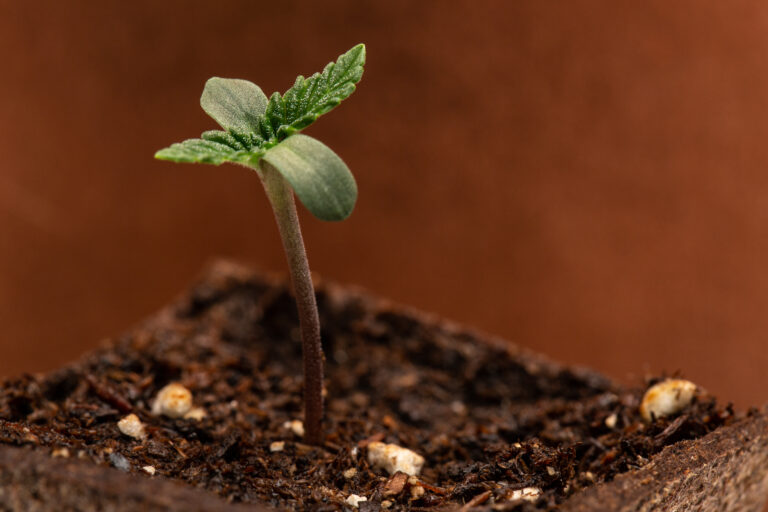 Photo by: Gina Coleman/Weedmaps
Photo by: Gina Coleman/WeedmapsImage lightbox

Checking the pH of your solution is as simple as using litmus paper or a handheld pH meter. If the solution is not in the recommended ranges, adjust the pH using simple acids or bases that are available at any plant nursery or grow shop. Cannabis prefers a slightly acidic environment, and its recommended parameters are:
- Soil: pH 6.0-6.8
- Hydroponics: pH 5.5-6.5
The bioavailability of each nutrient changes as you go up and down the pH scale. Plants prefer different pHs for maximum availability. That is why the recommended pH for cannabis is a range, not an exact number. This is also why monitoring your pH is more important than constantly correcting it. A little fluctuation is not a bad thing because it allows for the maximum uptake of both your macronutrients and micronutrients.
Nutrient solution strength
Just as the levels of individual nutrients change throughout a plant's life cycle, so does the total strength of the nutrient solution that it should be provided. Young plants require relatively low nutrient strengths, as they do not have the root system required to uptake a large amount of nutrients.
Plants that are overfed nutrients exhibit “leaf burn,” where the tips of the leaves start to turn yellow and brown and feel crispy. Underfed plants exhibit slow growth and become visibly fragile, and the leaves tend to turn a lighter green with some yellowing. Both overfeeding and underfeeding can be detrimental to a crop if left unaddressed.
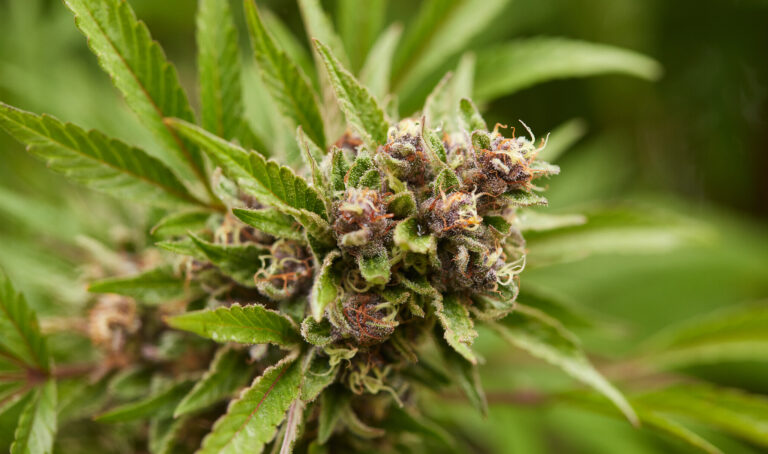 Photo by: Gina Coleman/Weedmaps
Photo by: Gina Coleman/WeedmapsImage lightbox

A handheld meter can measure the strength of nutrient solutions. These meters use probes to measure the electrical conductivity (EC), TDS, and PPM of a solution. Pure water is a bad conductor and has a conductivity close to zero. As you dilute salt-based nutrients into water, the electrical conductivity rises, giving you the total strength of the solution. Electrical conductivity is measured in millisiemens per centimeter (mS/cm).
Total dissolved solids are measured in PPM, which is the common unit when determining nutrient strength. It is important to consistently measure the strength of your nutrient solution throughout the growth cycle with a properly calibrated meter.
General EC feed strength guidelines:
- Propagation: 0.5-1.5 EC or 320-960 PPM
- Underfed Mature Plant: 1.5-2.0 EC or 960-1,300 PPM
- Optimal Range for Mature Plant: 2.0-3.6 EC or 960-2,300 PPM
- Too Much: Above 3.6 EC or 2,300 PPM
- Plant Damage: Occurs at or above 5.0 EC or 3,200 PPM
These feed strengths are a good example of why filtering your water is so important. If your starting water is at 1.0 EC (640 PPM), it will be impossible to mix a nutrient solution for your young plants with a strength of 1.0 EC. Adding an additional 1.0 EC of nutrients to that water would feed your young plants a solution that has a strength of 2.0 EC, twice the recommended strength.
Bottom line
Maintaining a healthy crop requires dedication and constant monitoring. The topics discussed above are all things that you, as the cultivator, have control over. Complete control over these parameters will reduce the chance of serious plant stressors, making it much easier to identify an issue when it arises.
Featured image by Gina Coleman/Weedmaps


